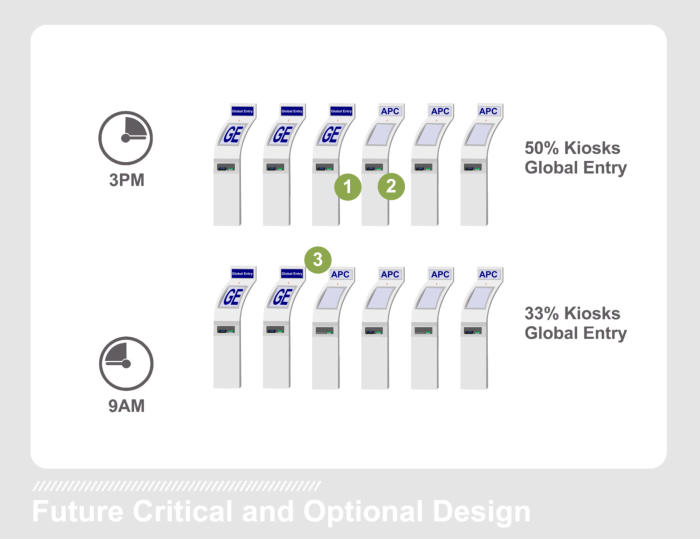

© National Safe Skies Alliance - Authored by InterVISTAS Consulting



CBP Airport Technical Design Standard

Finding 3: Adopt Convertible Processing Kiosks
Currently there are over 3,000 kiosks used to process passengers through a variety of DHS/CBP and TSA procedures. Throughout the hours of the day, days of the week, or seasonally, the demand for a particular kiosk type can be uneven. The percentage of passengers who use a particular kiosk type can vary significantly. For example, when flights arrive that largely have business passengers, the number of Global Entry kiosks needed is likely to be high compared to times when leisure travelers from a Visa Waiver Program country arrive.
Airport Applicability
- Medium to large passenger volumes - Most airport types - APC and Global Entry UsersReferences
ATDS (2012) - Section 3.5.4 describes the Trusted Traveler program and use and placement of kiosks - Section 7.4.2 suggests that space allocation be made in the primary hall for processing of trusted travelers. ATDS (2016 - 90% Draft) - Section 5.4.8 – use of kiosk in Automated Passport Control and Trusted Traveler and queueing area - Section 7.1 definition of APC and use of kiosks - Section 7.5.1 definition of Global Entry and use of kiosk - Code ATD-01-03 (A, C) in Chapter 5



© National Safe Skies Alliance
Authored by InterVISTAS Consulting

CBP Airport Technical Design Standard
Finding 3: Adopt Convertible
Processing Kiosks
There are over 3,000 kiosks used to process passengers through a variety of DHS/CBP and TSA processes. Throughout the hour of day, day of week, or seasonally, the demand for a particular kiosk type can be uneven. The percentage of passengers who use a particular kiosk can vary significantly. For example, when flights arrive that largely have business passengers, the number of Global Entry kiosks needed is likely to be high compared to times when leisure travelers from a Visa Waiver Program country arrive.

Kiosks must have all biometric
identification/verification features and
travel document readers integrated into
kiosks. Multi-use kiosks must be able to
perform biometric verification via
fingerprint or facial recognition/capture
with a camera.
Kiosk components (i.e. biometric
features and readers) should be
modular and be easily re-configurable
(plug-and-play) to meet border
processing needs.
Dynamic signage should be used for
wayfinding to communicate to
passengers which kiosks to use for
Automated Passport Control and which
bank of kiosks are for Global
Entry/trusted traveler. Each kiosk
should also have a dynamic display
above it to identify what mode the kiosk
is in.




































